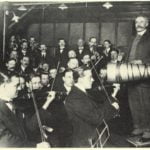It’s the time of year for saving money!
As all audiophiles are aware, the continuing, persistent disagreement on the benefit, or lack thereof, on cables, interconnects and power cords offering any worthwhile improvement to an audio system are very well known. Ask the average music listening audiophile if they believe and support cables as a viable source of sonic improvement and the answers will be quite diverse. They will range from complete agreement to total disagreement and the opinions might be devastatingly vulgar, refreshingly agreeable, and anything in between.
 When we look at cables in a high performance audio system, several facts come glaringly into focus. One, and obviously, some type of a piece of wire is required to connect the various components in a system. Let’s face it, wireless technology just isn’t that far along. Secondly, costs range from very inexpensive to outrageously, surprisingly, expensive. It’s very easy, for instance, to spend upwards of $50,000.00 for speaker cables. Of course, one might also use “zip cord,” at about $0.10 per foot (or close thereabouts) and whose predominate heretofore purpose was wiring table lamps. So what exactly is it one does the other does not?
When we look at cables in a high performance audio system, several facts come glaringly into focus. One, and obviously, some type of a piece of wire is required to connect the various components in a system. Let’s face it, wireless technology just isn’t that far along. Secondly, costs range from very inexpensive to outrageously, surprisingly, expensive. It’s very easy, for instance, to spend upwards of $50,000.00 for speaker cables. Of course, one might also use “zip cord,” at about $0.10 per foot (or close thereabouts) and whose predominate heretofore purpose was wiring table lamps. So what exactly is it one does the other does not?
When it comes to the technical aspect of cables, how they function, how they are designed and the engineering differences between the various technologies, making an informed choice may become somewhat overwhelming. Audiophile Review contributor Roger Skoff, someone who knows more about cable design and manufacturing than I ever will, has written numerous articles on how they function and why they matter in an audio system. And yet the decisively negative comments abound. Why? What is it about cables that makes one segment of the hobby in favor of their use and so many others seemingly in staunch opposition? Why can’t we all just get along?
That ship has certainly sailed.
 I’ve often wondered why it is that those who harbor such pervasive disagreement regarding cables are so resolute in their opposition. In theory, it seems like a simple process – get used to how a system sounds with an existing cable loom, then try a different cable on one or more components and determine if an improvement is yielded. If one is discovered, the answer is easily discerned. If not, maybe cable criticism has foundation – but only on that system utilizing that one particular wire because audio is universally system dependent. There is no one size fits all.
I’ve often wondered why it is that those who harbor such pervasive disagreement regarding cables are so resolute in their opposition. In theory, it seems like a simple process – get used to how a system sounds with an existing cable loom, then try a different cable on one or more components and determine if an improvement is yielded. If one is discovered, the answer is easily discerned. If not, maybe cable criticism has foundation – but only on that system utilizing that one particular wire because audio is universally system dependent. There is no one size fits all.
In spite of what seems like a simple process, we audiophiles argue over copper quality, use of silver, round designs, flat designs, interfaces at one end of a cable, power cords and how they matter given the home wiring, and well, the list goes on and on.
For those that have complete animosity towards cables as an integral part of a system, I continue to wonder to what degree they have tested and verified their hypotheses. Have they tested, in their own audio system, a significant cross section of those “expensive” cables they so completely despise? Is it just possible their derisive position on the cable subject is fueled by some disposition on how much cables might cost? In other words, “I don’t have to test it because nothing that expensive can ever be worth the money.” Is that the accepted methodology?
 It might also be argued that those spending as much as a nice sports car on a speaker cable are doing so as much to show off as any perceived auditory advancements that might be gleaned. They have the available funds and despite the fact that this wildly expensive cable makes no difference at all, they happily point out to their friends that this cable cost “X” number of dollars and yes it’s crazy, but I can afford it, and the possible underlying context – “and you can’t.” Is that the accepted methodology?
It might also be argued that those spending as much as a nice sports car on a speaker cable are doing so as much to show off as any perceived auditory advancements that might be gleaned. They have the available funds and despite the fact that this wildly expensive cable makes no difference at all, they happily point out to their friends that this cable cost “X” number of dollars and yes it’s crazy, but I can afford it, and the possible underlying context – “and you can’t.” Is that the accepted methodology?
When we look around our everyday lives, engineering advancements surround us. In our homes, look at how far the technology we routinely encounter has progressed. Comparing, for instance, incandescent light bulbs to LED the engineering advancements are plainly obvious. One basically costs less than a dollar and the other is many times that cost. Yet the benefits of LED are so glaringly obvious many homeowners are changing out those inexpensive and yesterday designed incandescent bulbs in favor of a better, more expensive technology. If the accepted reality is that engineering advancements can occur in a light bulb, and the cost justified, why not a piece of wire? Is it so difficult of a concept that engineering advancements in the three main properties of a cable – capacitance, inductance and resistance can manifest themselves and yield a better mousetrap?
 Cables are the dichotomous and prevailing argument in high performance audio. Cable veracity is so system dependent and so highly opinionated that no consensus of agreement will likely be reached anytime soon. There are those, like me, that have firm and resolute belief that cables make a difference in an audio system. I have heard the difference those “expensive” cables make in a system. I own them, I use them, I’ve tested them and I’ve compared them to something a fraction of their cost. So in my system, in my opinion, in my world, cables matter. I consider them as an indispensable part of an audio system. I consider them of equal importance to an amp, speaker or source. Verification of the worth of a cable can only occur through testing – and testing on an individual system through the use of a variety of variables. It is disingenuous to state that something cannot possibly work when no real world testing supporting the opposing position exists.
Cables are the dichotomous and prevailing argument in high performance audio. Cable veracity is so system dependent and so highly opinionated that no consensus of agreement will likely be reached anytime soon. There are those, like me, that have firm and resolute belief that cables make a difference in an audio system. I have heard the difference those “expensive” cables make in a system. I own them, I use them, I’ve tested them and I’ve compared them to something a fraction of their cost. So in my system, in my opinion, in my world, cables matter. I consider them as an indispensable part of an audio system. I consider them of equal importance to an amp, speaker or source. Verification of the worth of a cable can only occur through testing – and testing on an individual system through the use of a variety of variables. It is disingenuous to state that something cannot possibly work when no real world testing supporting the opposing position exists.
In spite of this, my position, and this article, will be absolutely vilified by many. There will be those in total disagreement with my position on the subject of cables. I understand that and am fine with dissenting viewpoints. Frankly, I would be quite surprised if it were any other way.








